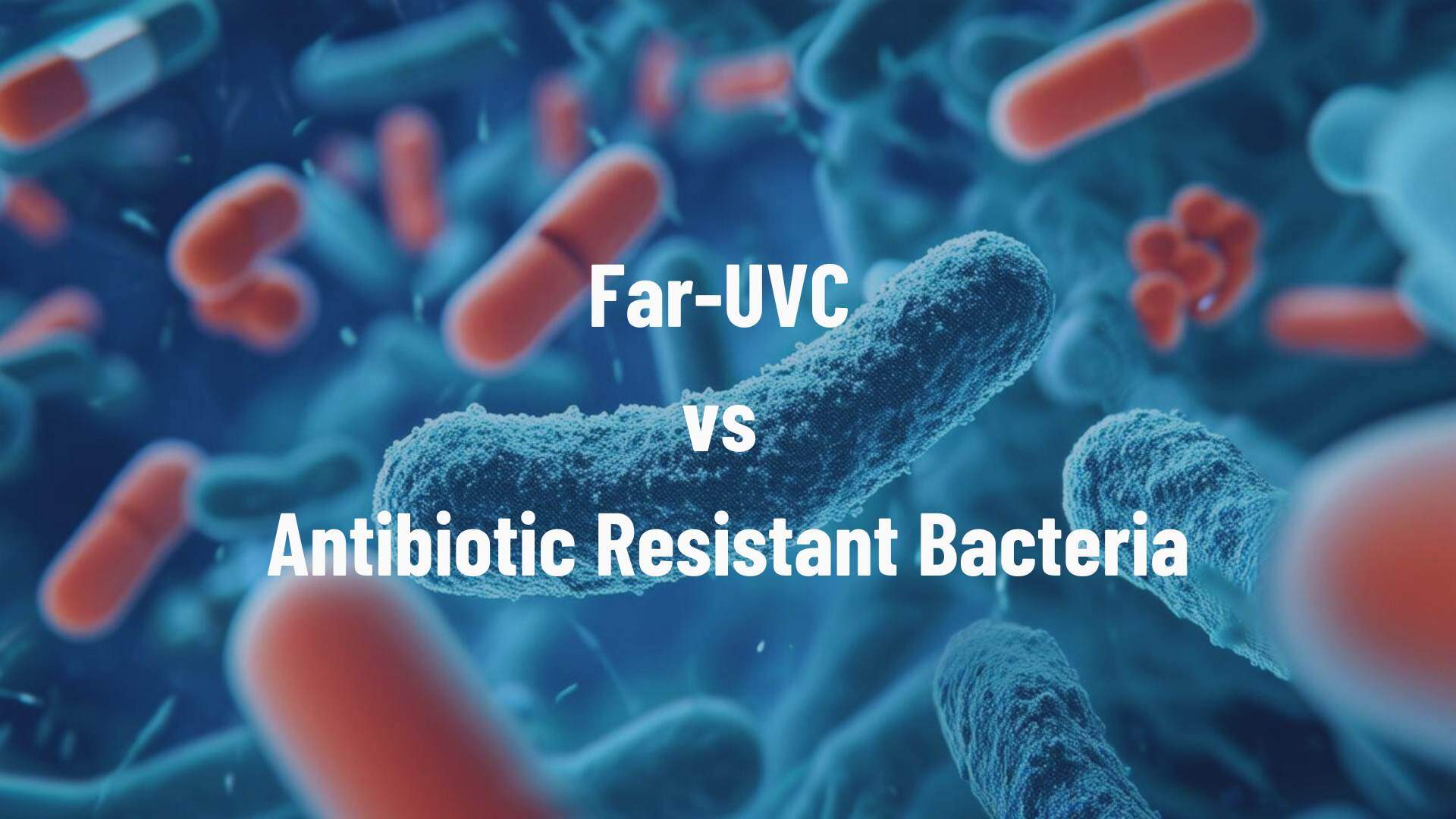4 min read
Reflecting on the Role of 222 nm Far-UVC in Combating COVID-19
 Cecilie Aaberg Meltofte
:
19 Dec, 2024
Cecilie Aaberg Meltofte
:
19 Dec, 2024

The COVID-19 pandemic laid bare the critical need for pioneering and effective infection control strategies in healthcare and pharmaceutical environments. As authorities in healthcare technology, our ongoing commitment to innovation compels us to examine transformative technologies that could have mitigated the pandemic's impact. Among these, Far-UVC technology at 222 nm stands out for its promise in the current fight against pathogens and potential in preempting future health crises.
222 nm Far-UVC: A Safety-Conscious Scientific Advancement
Far-UVC light at 222 nanometers exhibits unique safety profile that distinguish it from traditional UVC (254 nm). Its ability to inactivate a spectrum of microbes—viruses, bacteria, and fungi—without posing harm to human tissues is paramount. This technology's superficial penetration depth precludes it from affecting human skin and eyes, while effectively deactivating microbial replication processes.
The Untapped Potential During the COVID-19 Pandemic
The employment of Far-UVC 222 nm during the COVID-19 pandemic represents a missed opportunity for enhancing infection control. Here are the areas where its impact could have been monumental:
1. Continuous Airborne and Surface Disinfection
Implementing Far-UVC systems would have enabled continuous disinfection of air and surfaces in real time, significantly lowering viral loads within healthcare settings. This would have been particularly valuable in high-traffic areas such as hospital wards, emergency departments, and nursing homes where maintaining low pathogen prevalence is crucial.
2. Supplementing Protective Protocols
Given its safety for human exposure, Far-UVC could have been deployed in occupied spaces, offering continuous disinfection without requiring evacuation or introducing workflow interruptions. This feature complements existing hygiene practices like regular handwashing and surface cleaning, creating an optimal multilayered defense against pathogen spread.
3. Scalable and Seamless Integration
The adaptability of Far-UVC technology facilitates integration into existing infrastructures such as hospital bed panels, portable disinfection units, and overhead operating lighting fixtures. Such integration would have amplified infection control protocols with minimal infrastructural disruption, allowing for rapid deployment during health emergencies.
222 nm Far-UVC and Future Pandemic Readiness
Proactive utilization of Far-UVC can robustly fortify our defense against future pandemics. Its strategic deployment offers several advantages:
1. Proactive Infection Mitigation
Systematic application of Far-UVC technology can operationalize a foundational layer of continuous pathogen mitigation. This anticipatory approach can help curb the spread of not only nascent viral infections but also endemic pathogens, fundamentally altering public health responses.
2. Safety Assurance and Regulatory Compliance
Far-UVC adheres to stringent safety standards and can be engineered to meet prevailing regulatory requirements, ensuring it is efficient and safe for routine use in diverse settings.
3. Ongoing Research and Development
Continued research and development efforts will be pivotal in unlocking Far-UVC's full potential. Investigations into dosage parameters, and application methodologies will refine its utility in real-world scenarios, ensuring that we remain at the forefront of infection control innovations.
Broader Implications for Environmental Safety
Beyond its immediate application in healthcare settings, Far-UVC technology holds broader implications for public health safety. Its integration in spaces with high-density occupancy such as schools, airports, and public transport systems presents a proactive approach to reducing the spread of infectious diseases. In doing so, it lays the groundwork for more resilient public spaces that are better equipped to handle future health crises.
Conclusion
Reflecting on the COVID-19 pandemic, the strategic implementation of Far-UVC technology at 222 nm reveals itself as a vital instrument in modern infection control arsenals. By capitalizing on its unparalleled germicidal efficacy and safety profile, we can shape a more proactive and resilient public health framework. Leveraging Far-UVC technology is pivotal in safeguarding public health, ensuring preparedness for new and evolving pathogens, and reinforcing the confidence of both healthcare practitioners and patients in the safety of healthcare environments.
Link to studies
Far-UVC light (222 nm) efficiently and safely inactivates airborne human coronaviruses
222 nm far-UVC light markedly reduces the level of infectious airborne virus in an occupied room
Frequently Asked Questions About Far-UVC at 222 nm Technology
-
What is Far-UVC at 222 nm light, and how does it differ from traditional UVC light?
Far-UVC 222 nm light is a specific wavelength within the ultraviolet spectrum that has demonstrated significant germicidal properties. Unlike traditional UV-C light typically at 254 nm, Far-UVC 222 nm effectively inactivates bacteria, viruses, and spores while being safe for human exposure. This is because Far-UVC 222 nm penetrates only the outermost layers of human skin and eyes, thereby not causing the damage associated with conventional UV-C radiation.
-
How could Far-UVC at 222 nm have been utilized during the COVID-19 pandemic?
Far-UVC 222 nm could have played an instrumental role in mitigating the spread of SARS-CoV-2 by providing continuous disinfection of air and surfaces in real-time. Its deployment in high-traffic areas such as hospital wards, emergency departments, and pharmaceutical manufacturing facilities would have significantly reduced viral loads, thereby enhancing existing hygiene protocols without disrupting workflows.
-
Is Far-UVC at 222 nm safe for continuous human exposure in occupied environments?
Yes, Far-UVC 222 nm has been extensively studied and proven safe for continuous human exposure. Its minimal penetration depth ensures that it does not reach living cells in human skin or eyes, thus avoiding the harmful effects customary with conventional UV-C light. This allows Far-UVC systems to be used in occupied spaces, providing ongoing disinfection without necessitating evacuations.
-
How can Far-UVC at 222 nm technology be integrated into existing infrastructure?
Far-UVC technology is highly adaptable and can be integrated into various existing infrastructures with minimal disruption. It can be incorporated into HVAC systems, portable disinfection units, and overhead lighting fixtures. This seamless integration facilitates rapid deployment and scalability, enhancing infection control measures in healthcare settings and beyond.
-
What role does Far-UVC at 222 nm play in future pandemic preparedness?
Far-UVC 222 nm technology is crucial for future pandemic preparedness by providing a continuous, proactive layer of disinfection. Its ability to reduce pathogen prevalence in real-time can help curb the spread of emerging viral infections and endemic pathogens. This anticipatory approach, supported by ongoing research and compliance with stringent safety standards, positions Far-UVC as a key component of robust pandemic defense strategies.
-
Beyond healthcare, where else can Far-UVC at 222 nm technology be beneficial?
Far-UVC 222 nm technology holds broad implications for public health safety in various high-density environments. Its application in schools, airports, public transport systems, and other communal spaces can reduce the spread of infectious diseases, thus making these areas safer. By embedding Far-UVC within everyday operations, we can create a more resilient public infrastructure capable of handling future health crises effectively.
 UV222™
UV222™ UV222 Linear
UV222 Linear UV222 Downlight
UV222 Downlight Vertex 222
Vertex 222.png) UV222 Pendant
UV222 Pendant.png) UV222 Booth
UV222 Booth.png) UV222 Step-On
UV222 Step-On.png) UV222 Cleanroom Downlight
UV222 Cleanroom Downlight UV222 Dual Downlight 60x60
UV222 Dual Downlight 60x60 UV222 Material Airlock
UV222 Material Airlock UV222 Ambulance
UV222 Ambulance UV222 Compact
UV222 Compact UV222 Industrial
UV222 Industrial


.jpg)





